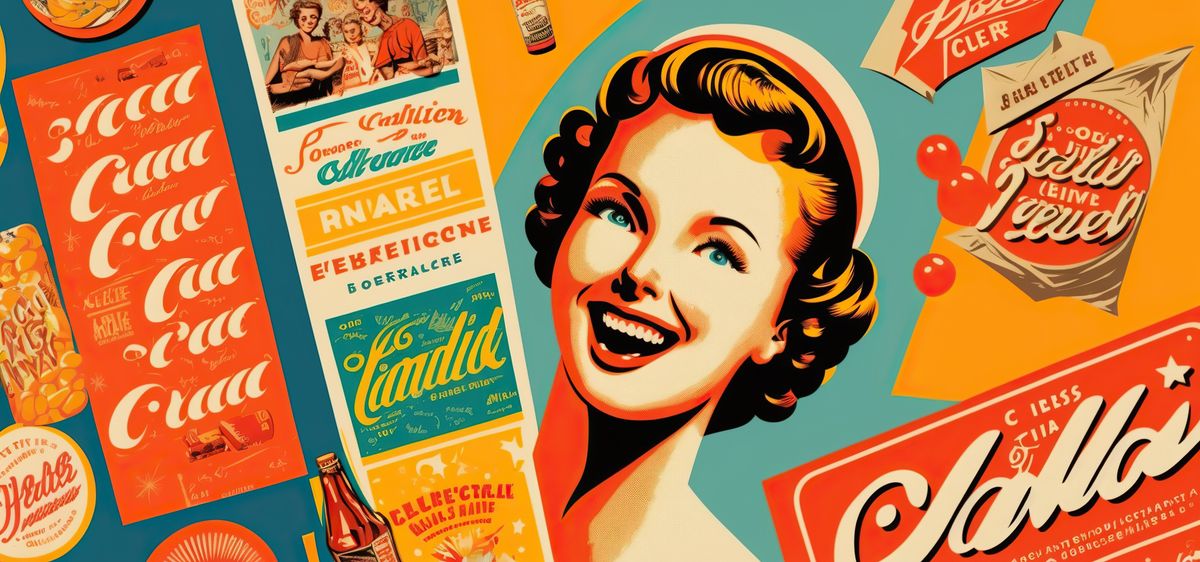
What Is Nostalgia Branding? Tips for Using This Powerful Trend to Appeal to Gen Z
Companies today are turning to nostalgia in their marketing as they seek to connect with a younger audience. Big-name brands like Pepsi, Burberry, and
Burger King have leveraged nostalgia in their recent redesigns, introducing new logos that are closely related to looks from the 1970s and 1980s. In pop culture, Netflix’s Stranger Things, set in the 1980s, illustrates our love for looking backward.
The internet, and the melting pot of eras it provides access to, has allowed Generation Z—individuals born between 1997 and 2012—to indulge in a kind of shadow nostalgia for the decades that they never actually lived through. Thanks to a fast-paced mash-up of streaming, memes, and social media sharing, brands are now dealing with an audience that has a very modern take on the past.
As a result, nostalgia in branding is changing. While a groovy logo might emphasize the timelessness of your products or the tongue-in-cheek personality of a brand, young consumers want to see more than a specific throwback in the brands they like.
Why is nostalgia branding so powerful?
Nostalgia is a perennial branding trend for several reasons. Most obviously, older brands that leverage nostalgia use it to emphasize their history (exemplified in Burberry’s new logo), and new brands can create history where there isn’t any. Appearing as a historied brand can increase trust and the perception of quality in a product, and it can also help build a brand story.
But this misses the heart of why nostalgia is such a powerful method for connecting with your audience. As with every effective branding strategy, the success of nostalgia lies in the feelings that it evokes in your audience: comfort, safety, and maybe a sense of escapism.
And it’s backed up by science. In studies where researchers have used smells, sounds, or sights to induce memories in test subjects, the experience is reported as powerful and positive.
In the post-Covid years, as inflation and economic uncertainty continue to squeeze living standards and as a 24-hour news cycle feeds us images of wars across the globe, it’s no surprise that consumers are looking to the past for a comfort they can’t find in the present.
The psychology of nostalgia relies on memory to invoke powerful emotions. You might expect it to work best on older consumers who keep their rose-tinted glasses in their shirt pockets, but research has shown that younger generations are strongly drawn to nostalgic branding.
Gen Z is predicted to become the majority nonwhite demographic by 2026, and as the oldest Zoomers are now in their mid to late twenties their purchasing power has grown. Businesses need to know how to appeal to this demographic.
How Gen Z is changing nostalgia branding
In part, Gen Z leans towards nostalgia because they’re involved in a complex search for meaning, a reaction to the perception that online life is increasingly false, thanks to constant social media posting and sophisticated photo filters. And this makes authenticity an important value among this generation.
Having grown up fully online, Gen Z has always had access to media from the last 50+ years, and has the ability to mix and match eras for nostalgia. Nostalgia isn’t limited to only times they’ve experienced, because they’ve experienced the pop culture of every era, online, since day one.
To fully witness this phenomenon, look no further than the Netflix’s series Sex Education, which predictably struck home with a Gen Z audience. Sex Education stylistically mixes decades to create a timeless backdrop. It mixes things up even further with a brazenly transatlantic setting: its British students attend an American-style high school with letterman jackets and personal lockers.
Sex Education looks 1980s, but everyone has a smartphone—it’s now, it’s then, it’s everything all at once, and Gen Z is better able than generations before them to internalize this aesthetic. Zoomers don’t have a problem with straddling styles, decades, and even identities.
Similarly, Pepsi’s latest logo straddles decades: style elements from Pepsi's 1950s and 1980s logos are integrated into the new design. Danone-owned brand Silk’s Nextmilk launched last year with a creative campaign that played with the past, putting a classic ‘90s “Got Milk” mustache on celebrities and influencers, including the children of those who had been featured in the original campaign.
While it sounds overwhelming (and no doubt it can be), this also gives brands more opportunities for creative campaigns that will resonate with a young audience. But to harness it, an understanding of how Gen Z experiences nostalgia isn’t enough—brands also need to understand why this generation, in particular, is looking back.
Take sunscreen brand Vacation, for example. With a brand style firmly rooted in ‘80s beach culture, a scroll through Vacation's Instagram feed is like stumbling upon a 1980 issue of Cosmopolitan magazine. At first glance, the photos may appear superficial, but Vacation's brand tone tells its audience, “These people haven’t got a care in the world,” and chiseled, tanned faces have grins that scream, “I can afford to buy a house.”
It’s not just about the look—it’s a direct appeal to Zoomer’s longing for a simpler, carefree time.
How to use nostalgia in your branding
When Generation Z looks back to the 1980s, it’s about more than hot pink color schemes. While attitudes of the past might be outright rejected with an offhand “Okay, Boomer” (or even “Okay, Millennial), Gen Z yearns for the communities, connectedness, and comfort of past times, and is drawn to simpler living. It’s about the hunt for meaning in a confusing, modern world.
Incorporating nostalgia into your brand tone provides the opportunity for colorful and creative campaigns. But what’s more, it can link your product with a fundamental escapism from the modern world. Here’s how to do it:
Connect style with experience
A logo redesign or full-blown rebranding might be out of reach or simply too risky for your business, but that doesn’t mean you can’t play with nostalgia in your marketing and branding. Whether you’re designing a billboard ad, a social media post, or a new product line, allow nostalgia to guide your style choices.
Certain style choices invoke different feelings. For example, ‘70s color palettes of brown, beige, and orange invoke hominess, family, and stability to a Gen Z audience. Meanwhile, ‘80s tones—hot pink and neon—emphasize freedom and creativity. Make sure your nostalgia marketing choices are connected to the values your audience is craving a “return” to.
Invoke past times with a fresh twist
Gen Z’s hypermodern experience with the past gives brands the chance to be creative in their branding choices. Don't settle for a simple throwback—be bold and mix and match eras. Get playful in your ads by introducing modern elements, such as incorporating a voice assistant in familiar scenes of the past or combining the music from one era with the imagery from another, and create an overlapping experience of nostalgia.
Use nostalgia on social media
Social media is a great place to drop a nostalgia bomb for your audience, and font choices for overlay text and filters can offer instant nostalgia. Make sure to pair your rose-tinted social posts with captions that express what your audience is really looking for—a meaningful connection to hopes and dreams in the here and now.
Be mindful of appropriation
For newer brands, nostalgia branding means leveraging eras and experiences that are not part of your brand's history. However, when drawing on the past, you might find yourself looking back on cultures outside your own, so be careful not to cross the line into appropriation.
Ask yourself whether the nostalgia you’re invoking is specific to a minority group and whether that’s something you have legitimate access to. No one group can claim the free-wheeling ‘80s appeal of roller skates, but if you’re using culturally specific experiences, like the Black Power movement of the 1960s and 1970s, then take a moment for introspection.
Learning from the past
When discussing the return of Pepsi’s retro logo, PepsiCo chief design officer Mauro Porcini explained, "In approaching the new design, we asked ourselves: how do we take everything we love about Pepsi and its past, and create something that transcends?"
Brands looking to leverage nostalgia have a deep creative playbook to draw from, and this type of branding will become increasingly important for a demographic that has little excitement for the future. But branding can’t be negative, and nostalgia branding has to emphasize the positives of the past without painfully reinforcing the challenges of the present.
Nostalgic branding should evoke a feeling that's often associated with bygone eras. For Gen Z, that means an escape from hustle culture, from smartphones, and from a 24/7 news cycle. If you can create this feeling in your marketing, you’ll create a powerful connection with your audience.
FAQs about nostalgia branding in marketing
What is nostalgia branding?
Nostalgia branding uses style choices and other symbols to link products or services with past eras, invoking positive associations, fond memories of your audience, and the powerful values of times gone by.
Why is nostalgia so powerful in advertising?
Research has shown that using sights, sounds, and smells to invoke memories in test subjects creates a strong, positive experience. Nostalgia branding uses these techniques to create a powerful emotional connection with your audience.
How can brands use nostalgia?
Use color schemes (such as orange/brown for the 1970s and hot pink for the 1980s), font choices (such as serif fonts to invoke a historied feel), and symbols of the past (for example, fashion choices or retro vehicles) to create a nostalgic feel in your branding.
About the Author
Lotte Reford is Communications Lead for Squadhelp.com, a naming and branding platform with more than 40,000 customers globally, from the smallest startups to corporations like Nestle, Philips, Hilton, and Pepsi.
Company: Squadhelp
Website:
www.squadhelp.com
Connect with me on
LinkedIn.




